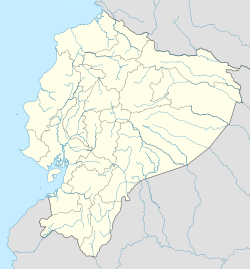Babahoyo
| Babahoyo | ||
|---|---|---|
|
||
| Coordinates: 1°48′0″S 79°32′24″W / 1.80000°S 79.54000°W | ||
| Country |
|
|
| Province |
|
|
| Canton |
|
|
| Foundes | 1796 | |
| Government | ||
| • Mayor | Jhonny Terán Salcedo | |
| Area | ||
| • City | 174.58 km2 (67.41 sq mi) | |
| • Metro | 1,087.31 km2 (419.81 sq mi) | |
| Elevation | 8 m (26 ft) | |
| Population (2010 census) | ||
| • City | 96,956 | |
| • Density | 560/km2 (1,400/sq mi) | |
| • Metro | 153,776 | |
| • Demonym | Babahoyense | |
| Time zone | UTC-5 hours | |
| Area code(s) | (+593) 5 | |
| Climate | Aw | |
| Website |
www |
|
Babahoyo (Spanish pronunciation: [baβaˈoʝo]), founded September 30, 1948, by legislative decree, is the capital of the Los Ríos province of Ecuador. Its population is cited around 153,000. It is bordered by two rivers, the San Pablo and the Caracol, which join to form the Babahoyo River. This meets the Daule River to form the Guayas River, which runs to the Pacific Ocean at the Gulf of Guayaquil.
A processing and trade center for the surrounding agricultural region, the city handles rice, sugarcane, fruits, balsa wood, and tagua nuts (vegetable ivory). Rice and sugar are also milled here.
The city is located in on the left bank of the San Pablo River, which unites in its estuary with the Catarama River to form the Babahoyo River. One of the most interesting excursions one can take in the area is a boat trip on the Babahoyo River. Babahoyo is located in Litoral and is an obligatory stop to reach the mountains through the highways Babahoyo – Quito (Via Panamericana), Babahoyo – Ambato (Via Flores) and also through Babahoyo – Riobamba. Babahoyo is located in the south of the province of Los Ríos. The roads that unite it with other cities and towns in the coast are Babhoyo – Baba, Babahoyo – Guayaquil and Babahoyo – Milagro. Its geographical location is one of the best because more than 25000 cars, buses, trailers and trucks pass through Babahoyo every day. Babhoyo is a commercial center between the coast and the mountains. Through the urban road network, the city counts on two pedestrian bridges that permit communication between Barreiro and El Salto. There are four bridges for vehicles: the first two cross the Catarama River and the San Pablo river in the north of the city (highway Babahoyo – Quito); the third crosses the Lagarto marsh in the south of the city (highway Babahoyo – Guayaquil); and the fourth is located in the sector of La Ventura (highway Babahoyo – Ambato).
...
Wikipedia


